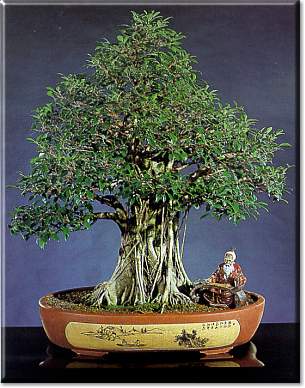|
 Indoor bonsai preeminently, Ficus can stand almost any kind of room condition, included the dry air of our flats. Indoor bonsai preeminently, Ficus can stand almost any kind of room condition, included the dry air of our flats.
It exists in hundreds of varieties, mainly coming from the Tropics.
By a good maintenance they show a beautiful dark green foliage, and some of them (as Ficus formosanum) bear fruits even when cultivated as bonsai.
Mature trees produce air roots: their vertical, sinuous movement gives the tree a particularly exotic, majestic and wild appearance.
Ficus coming from Formosa are particularly appreciated for their tiny leaves (s. photo).Location
Place outdoor from May to September. When indoor place it in a bright position.  Watering Watering
More frequent during the growing season, less frequent in winter. Remember to let the soil dry before watering again. On regular basis it is advisable to spray the leaves, but if you use tap water it is better to neutralize the harmful salts using the Bonsan Decalcifying Solution.
Fertilizing
When the tree starts its vegetative growth (March-April) apply every 8 days the Bonsan Stimulant Fertilizer together with the Bonsan Liquid Organic Fertilizer. From April to September fertilize every 8-10 days with Bonsan Liquid Organic Fertilizer or every 15-20 days with the Bonsan Solid Organic Fertilizer Aburakasu, except for July and August. From September to February apply every 15-20 days the Bonsan Liquid Organic Fertilizer. Transplanting
On alternate years repot trees in late spring using akadama (40%) + ready bonsai soil (30%) + coconut fibre (20%) + coarse river sand (10%). |
|
 Coming from India, China and south-eastern Asia it belongs to a surprisingly wide family of 4500-5000 species. Coming from India, China and south-eastern Asia it belongs to a surprisingly wide family of 4500-5000 species.
It is an evergreen shrub with small leaves (green or variegated), well ramified, which flowers occasionally all over the year with tiny, white or pink flowers.
Roots are entangled and tortuous even on young trees and create an interesting contrast with the delicate flowers, which recall the snow flakes.
Just for curiosity: Serissa is called "foetida" because of the smell given off by the roots, yet noticeable just while repotting.Location
From May to September place outdoor in half-shade position. When placed indoor choose a very bright and cool position between 13-18°C. Pay attention to draughts.  Watering Watering
More frequent in summer, but regular in winter. Avoid overwatering. Frequent spraying on foliage is appreciated, but in case of tap water it is better to neutralize the harmful salts using the Bonsan Decalcifying Solution.
Fertilizing
When the tree starts its vegetative growth (March-April) apply every 8-10 days the Bonsan Stimulant Fertilizer together with the Bonsan Liquid Organic Fertilizer. From April to September fertilize every 8-10 days with the Bonsan Liquid Organic Fertilizer or every 15-20 days with the Bonsan Solid Organic Fertilizer Aburakasu, except for July and August. From September to February apply every 15-20 days the Bonsan Liquid Organic Fertilizer. Transplanting
Every 2-3 years in April. Recommended soil: akadama (50%) + ready bonsai soil (40%) + coarse river sand (10%).
|
 Indoor bonsai preeminently, Ficus can stand almost any kind of room condition, included the dry air of our flats.
Indoor bonsai preeminently, Ficus can stand almost any kind of room condition, included the dry air of our flats. Coming from India, China and south-eastern Asia it belongs to a surprisingly wide family of 4500-5000 species.
Coming from India, China and south-eastern Asia it belongs to a surprisingly wide family of 4500-5000 species. Watering
Watering Watering
Watering